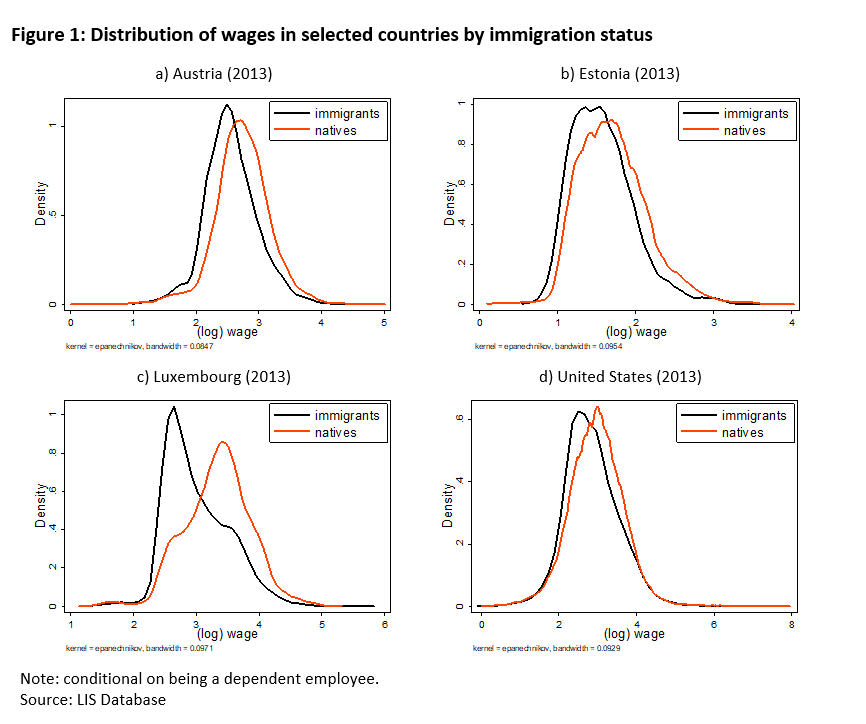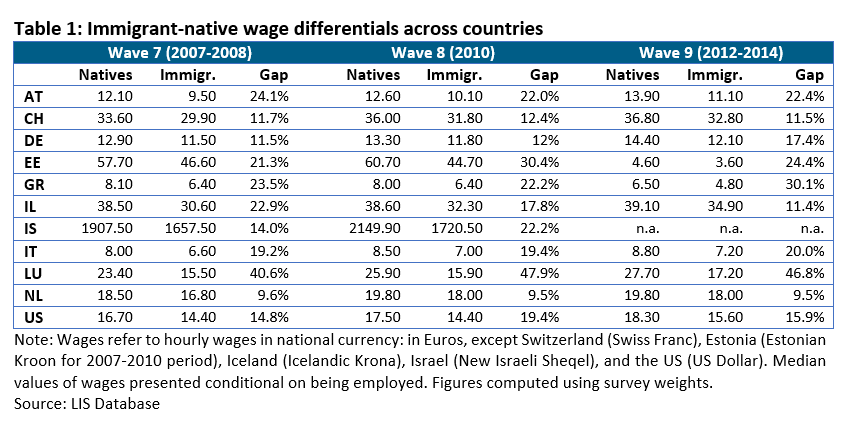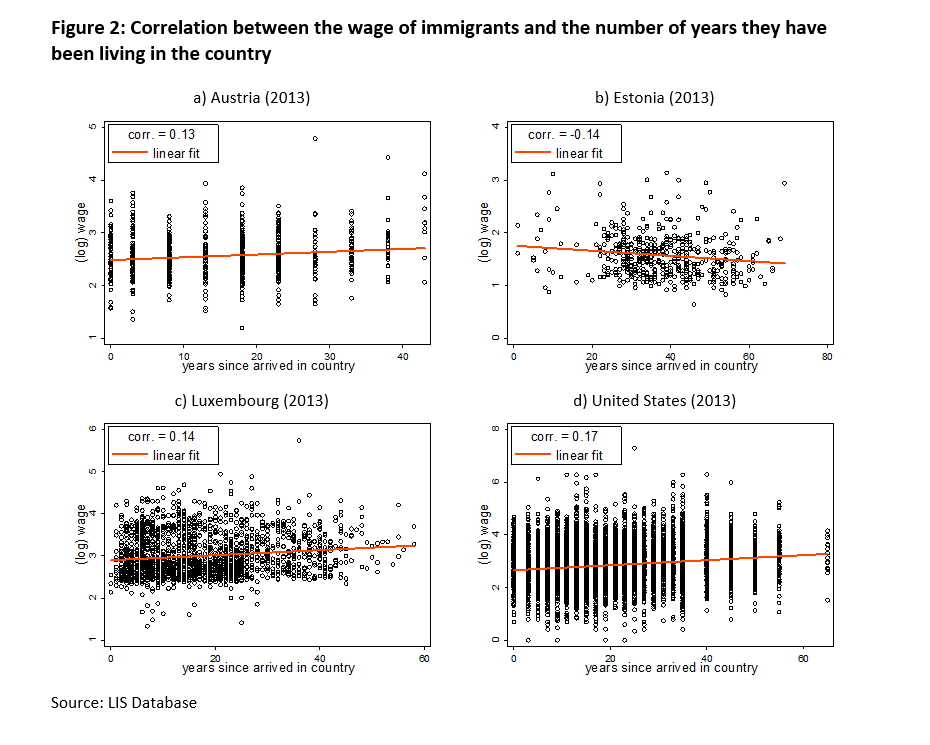Issue, No.6 (June 2018)
Immigrant-native wage gaps: evidence from the LIS Database
Disclaimer: The views and results presented in this paper are those of the authors and do not necessarily represent the official opinion of the European Commission. Any remaining errors are solely ours.
The issue of systematic differences in labor market outcomes between otherwise comparable vulnerable/discriminated groups of individuals (e.g. ethnic minorities, immigrants, etc.) on the one hand and the mainstream population on the other hand has received considerable attention in the labor economics literature as well as from policymakers during the last years.
The vast majority of previous empirical studies have been based on a single-country analysis (e.g Van Kerm et al. (2016) for Luxembourg, Lemos (2017) for the UK, and Smith and Fernandez (2017) for the US and Canada). One disadvantage of single-country studies is that they can say little about a global extent of the problem. Only few studies have analyzed the problem in a broader international context, including Fortin (2005) or Guzi et al. (2015), who employ international microdata. However, the focus of these studies is mainly on differences in the labor force participation of immigrants versus natives rather than wage differentials.
In this short note we offer a snapshot on the immigrant-native wage gaps in 11 high-income OECD countries based on cross-nationally harmonized and comparable microdata coming from the Luxembourg Income Study (LIS) Database covering the period from 2007 to 2014. While in total the LIS Database covers about 50 countries around the world, the immigration status 1 and wages 2 (our outcome variable) can be observed in a comparable way only for a subset of countries: Austria (AT), Switzerland (CH), Germany (DE), Estonia (EE), Greece (GR), Israel (IL), Iceland (IS), Italy (IT), Luxembourg (LU), the Netherlands (NL), and the United States (US).
Our descriptive results suggest that the wage gap 3 between natives and a foreign-born population is present in the majority of countries. Figure 1 illustrates the distribution of wages (for selected countries) by immigration status. The data suggest that the wage gap is the most obvious in Luxembourg. As summarized in Table 1, wage differentials (at the median) between natives and immigrants vary between around 9% in the Netherlands to more than 40% in Luxembourg across the 11 countries and over time.


Furthermore, in Figure 2 we zoom in at the level of earnings of immigrants in selected countries versus the time they have lived in the receiving country which we use as a proxy for their integration/assimilation4 . The results indicate that there is no significant correlation between the two variables, hence the wage gap does not close for those foreign-born individuals who have been living in the receiving country even for decades. These results indicate that there might be present impediments hindering migrants’ integration in the labor markets in the selected OECD countries. This suggests that the potential of policies towards addressing integration of migrants into the labor market has not been fully reached.

For example, a study by Guzi et al. (2015) reveals that in the EU, institutional indicators including differences among welfare systems, trade openness, and employment protection legislation are responsible for a large part of the immigrant-native gap in employment. In addition, Kancs and Lecca (2018) have assessed long‐term social, economic and fiscal effects of immigration into the EU of alternative integration policies: status quo versus forward-thinking integration policies. They find that, although less costly in
the short-run, the social, economic and fiscal benefits of currently implemented migrant integration policies in EU Member States are likely to be considerably lower in the long-run, when compared to the potential of forward-thinking integration policies.
However, a further more comprehensive research agenda is needed to evaluate the effectiveness of integration policies and policies promoting equality of opportunities as well as their socio-economic implications in the long-run. As the next step, we aim to apply various decomposition techniques from the labor economics and policy evaluation literature to provide a more nuanced analysis of the immigrant-native wage gaps. LIS microdata offer a good opportunity for conducting analyses in this subject, as the available country coverage allows for a broader analysis beyond the European context.
1 In our case, the immigration status is a binary variable taking the value of 1 if an individual was born outside of the considered country. We do not consider individuals born outside the country whose parents were actually born in a domestic country as immigrants. For details on the immigration status see the online documentation system
2 Wages in our context are defined as gross (net) hourly wage earned in the first dependent job. We do not consider wages of the self-employed as they are often not reported.
3 We note that individuals differ along many dimensions like work experience or education – the human capital factors which need to be considered in any analysis on wage differentials – which we have not considered in this short note. These differences are relevant and need to be considered when conducting a thorough empirical investigation.
4 As noted by Venturini (2017), the two terms are used interchangeably among economists with the same connotation. We are aware that, ideally, one would like to measure assimilation of migrants by a variable capturing their working experience with individual-level panel data, however, this is not feasible with the LIS microdata.
References
| Fortin, N. M. (2005). Gender role attitudes and the labour-market outcomes of women across OECD countries. Oxford Review of Economic Policy 21(3), 416–438. |
| Guzi, M., Kahanec, M., & Kureková, L. M. (2015). What Explains Immigrant-Native Gaps in European Labor Markets: The Role of Institutions (No. 8847). IZA Discussion Papers. |
| Kancs, D. and Lecca, P. (2018). Long‐term social, economic and fiscal effects of immigration into the EU: The role of the integration policy, World Economy, https://doi.org/10.1111/twec.12637. |
| Lemos, S. (2017). Mind the gap: A detailed picture of the immigrant-native earnings gap in the UK using longitudinal data between 1978 and 2006. Regional Science and Urban Economics 63, 57–75. |
| Smith, W. C. and F. Fernandez (2017). Education, Skills, and Wage Gaps in Canada and the United States. International Migration 55(3), 57–73. |
| Van Kerm, P., Yu, S. and Choe, C. (2016). Decomposing quantile wage gaps: a conditional likelihood approach. Journal of the Royal Statistical Society: Series C (Applied Statistics), 65(4), 507-527. |
| Venturini, A. (2017). Immigrant Assimilation in the Labour Market: What Is Missing in Economic Literature. In Weinar, A., Unterreiner, A., Fargues, P.(eds.) Migrant Integration Between Homeland and Host Society Volume 1 (pp. 21-42). Springer, Cham. |
